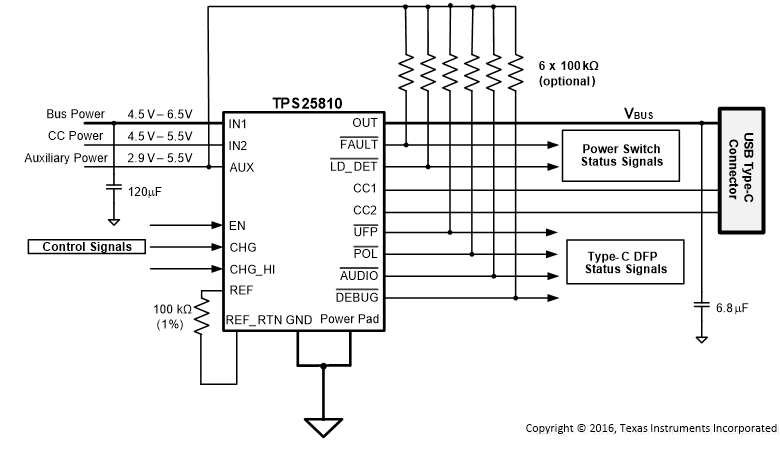-
TPS25810 USB Type-C DFP Controller and Power Switch with Load Detection
- 1 Features
- 2 Applications
- 3 Description
- 4 Revision History
- 5 Pin Configuration and Functions
- 6 Specifications
-
7 Detailed Description
- 7.1 Overview
- 7.2 Functional Block Diagram
- 7.3
Feature Description
- 7.3.1 Configuration Channel Pins CC1 and CC2
- 7.3.2 Current Capability Advertisement and Overload Protection
- 7.3.3
Undervoltage Lockout (UVLO)
- 7.3.3.1 Device Power Pins (IN1, IN2, AUX, OUT, and GND)
- 7.3.3.2 FAULT Response
- 7.3.3.3 Thermal Shutdown
- 7.3.3.4 REF
- 7.3.3.5 Audio Accessory Detection
- 7.3.3.6 Debug Accessory Detection
- 7.3.3.7 Plug Polarity Detection
- 7.3.3.8 Device Enable Control
- 7.3.3.9 Load Detect
- 7.3.3.10 Power Wake
- 7.3.3.11 Port Power Management (PPM)
- 7.3.3.12 Implementing PPM in a System with Two Type-C Ports
- 7.3.3.13 PPM Operation
- 7.4 Device Functional Modes
- 8 Application and Implementation
- 9 Power Supply Recommendations
- 10Layout
- 11Device and Documentation Support
- 12Mechanical, Packaging, and Orderable Information
- IMPORTANT NOTICE
Package Options
Mechanical Data (Package|Pins)
- RVC|20
Thermal pad, mechanical data (Package|Pins)
- RVC|20
Orderable Information
TPS25810 USB Type-C DFP Controller and Power Switch with Load Detection
1 Features
- USB Type-C Rev. 1.2 Compliant DFP Controller
- Connector Attach/Detach Detection
- STD/1.5-A/3-A Capability Advertisement on CC
- Super Speed Polarity Determination
- VBUS Application and Discharge
- VCONN Application to Electronically Marked Cable
- Audio and Debug Accessory Identification
- 0.7-µA (typ) IDDQ When Port Unattached
- Three Input Supply Options
- IN1: USB Charging Supply
- IN2: VCONN Supply
- AUX: Device Power Supply
- Power Wake Supports Low Power in System Hibernate (S4) and OFF (S5) Power States
- 34-mΩ (typ) High-Side MOSFET
- 1.7/3.4-A ILimit (±7.1%) - Programmable
- Port Power Management Enables Power Resource Optimization Across Multi-Ports
- Package: 20-Pin WQFN (3 x 4) (1)
- UL Listed – File No. E169910
2 Applications
- USB Type C Host Port in Notebook for Sleep Charging
- LCD Monitor/Docking Station and Charging Cradles
- Type C USB Wall Chargers
3 Description
The TPS25810 is a USB Type-C Downstream Facing Port (DFP) controller with an integrated 3-A rated USB power switch. The TPS25810 monitors the Type-C Configuration Channel (CC) lines to determine when an USB device is attached. If an Upstream Facing Port (UFP) device is attached, the TPS25810 applies power to VBUS and communicates the selectable VBUS current sourcing capability to the UFP via the passthrough CC line. If the UFP is attached using an electronically marked cable, the TPS25810 also applies VCONN power to the cable CC pin. The TPS25810 also identifies when Type-C audio or debug accessories are attached.
The TPS25810 draws less than 0.7 uA (typ) when no device is attached. Additional system power saving is achievable in S4/S5 system power states by using the UFP output to disable the high power 5-V supply when no UFP is attached. In this mode the device is capable of running from an auxiliary supply (AUX) which can be a lower voltage supply (3.3 V), typically powering the system uC in low power states (S4/S5).
The TPS25810 34-mΩ power switch has two selectable fixed current limits that align with the Type-C current levels. The FAULT output signals when the switch is in an over current or over temperature condition. The LD_DET output controls power management to multiple high current Type-C ports in an environment where all ports cannot simultaneously provide high current (3 A).
Device Information(1)
| PART NUMBER | PACKAGE | BODY SIZE (NOM) |
|---|---|---|
| TPS25810 | WQFN (20) | 3.00 mm x 4.00 mm |
- For all available packages, see the orderable addendum at the end of the data sheet.
4 Revision History
Changes from B Revision (May 2016) to C Revision
- Changed Feature From: USB Type-C Rev. 1.1 Compliant DFP Controller To: USB Type-C Rev. 1.2 Compliant DFP Controller Go
- Changed text From: Type-C spec revision 1.1 To: Type-C spec revision 1.2 in the Overview sectionGo
- Replaced Figure 15 Go
Changes from A Revision (September 2015) to B Revision
- Added CC pins IEC-61000-4-2 rated footnoteGo
- Changed from UL and CB Tests Underway to UL Listed – File No. E169910 in FeaturesGo
- Changed 10µF to 6.8µF in Simplified SchematicGo
- Added text to REF description Go
- Added IEC information to ESD Ratings Go
- Changed IN2 II parameter description in Electrical Characteristics Go
- Changed tres to tios in Switching Characteristics Go
- Added text to Detecting a Connection section Go
- Changed Rp to Rds in Figure 12 Go
- Changed loss to drop in Figure 14 Go
- Added text and Figure 15 to Plug Polarity DetectionGo
- Added last sentence to Input and Output Capacitance Go
- Added ESD Considerations to Layout GuidelinesGo
- Added Protecting the TPS25810 from High Voltage DFPs to Related DocumentationGo
Changes from * Revision (September 2015) to A Revision
- Changed from Product Preview to Production DataGo
5 Pin Configuration and Functions

